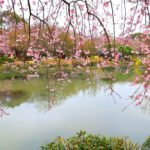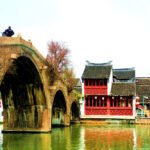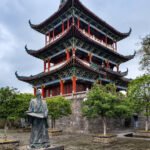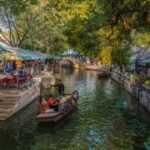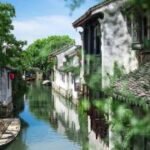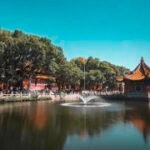Panmen Gate is located at the southwest corner of Suzhou’s ancient city. Among the many ancient city gates in China, Panmen stands out as the only surviving dual-purpose water and land city gate in the country. This uniqueness is attributed to the extensive water network of Suzhou, which dictated its construction according to local conditions. Within the Panmen scenic area, in addition to the gate itself, the Wu Men Bridge and Rui Guang Pagoda are also worth visiting, collectively known as the ‘Three Views of Panmen’. Panmen was initially constructed in the first year of the Spring and Autumn period during the state of Wu (514 BC), as one of the eight city gates built by Wu Zixu in Suzhou. The existing Panmen is a reconstruction from the Yuan Dynasty. Ascending Panmen along the horse racing path allows one to view the entire panorama of the water and land gates. The water gate is on the outer side (south), consisting of two gates, with the canal flowing beneath the city gate. Between the two gates, a square-shaped water city moat is formed, with a secret passage leading to the city tower. The land gate is on the inner side (north), also consisting of two gates, with a square-shaped land city moat between them, housing hidden soldier caves capable of concealing hundreds of soldiers. Even if the enemy breached one gate, the ambushed soldiers could effectively ‘catch the turtle in the jar’. Panmen is also connected to a city wall over 300 meters long. Walking along Panmen, one can discover loopholes, sluice gates, windlass stones, and several cannons from the Qing Dynasty, providing a very intuitive understanding of Panmen’s role in ancient military defense. The city tower on Panmen was reconstructed in 1986. To the west of Panmen is the Wu Xiang Temple, a memorial to Wu Zixu, which is a modern reconstruction. The only original artifact from the Tang Dynasty is a pair of thousand-year-old flagstone holders used for flagpoles in the northern part of the temple. The temple consists of a hall, corridors, and a garden, with the eastern courtyard often hosting performances such as Pingtan. South of Wu Xiang Temple, at the Shuicheng Tanyou Wharf, one can take a free rowing boat. The boat passes under the two water gates of Panmen, allowing passengers to look up at the city gate, with ivy climbing the ancient gateway, a mix of grandeur and the delicacy of a water town. The boat then returns along the moat outside the city, with the entire journey taking about 10 minutes. The boatwoman may sing in the Wu dialect and might ask for a tip. To the south of Panmen is the Wu Men Bridge, which was originally constructed in the seventh year of the Northern Song Dynasty’s Yuanfeng era (1084 AD). Initially, it was connected by three bridges, but it was later rebuilt into the single-arch stone arch bridge we see today during the late Qing Dynasty. The bridge stands about 10 meters high and is a single-arch stone arch bridge in Suzhou. It offers a great angle for photographing Panmen. To the northeast of Panmen is the Rui Guang Pagoda, said to have been built by Sun Quan of the Three Kingdoms to repay his mother’s kindness. It was rebuilt in the first year of the Northern Song Dynasty’s Jingde era (1004 AD), destroyed in the late Qing Dynasty due to war, and then restored. The tower has seven stories, and from the top, one can overlook the Panmen scenic area. The pagoda is famous because in 1978, a true pearl sarira pagoda was discovered in the third-level celestial palace of the tower, which is now one of the treasures of the Suzhou Museum. After viewing all the ‘Three Views of Panmen’, one can stroll around the scenic area. With the canal flowing through, small bridges, artificial hills, and pavilions, visitors can take photos and feed the koi fish in the water.
If you still have the desire to explore more, Canglang Pavilion is not far from the northeast side of Panmen Gate. Further east lies the Master of Nets Garden, both of which are adjacent to Shiquan Street, a well-known food and handicraft street in Suzhou, which can be visited together. The opening hours are from January 1st to September 14th, 08:30-21:00; September 15th, 08:30-18:00; and from September 16th to December 31st, 08:30-21:00. The business activities within the scenic area are not restricted by the normal business hours of the scenic spot. Preferential policies apply to children: under 6 years old (inclusive) or under 1.4 meters in height (inclusive), free; minors: from 6 years old (exclusive) to 18 years old (inclusive), half price with valid identification; students: full-time undergraduate and below students, half price with valid identification; the elderly: from 60 years old (inclusive) to 69 years old (inclusive), half price with valid identification; 70 years old (inclusive) and above, free with valid identification; disabled persons and one accompanying person for severely disabled persons: free with valid identification; active-duty military personnel: free with valid identification; retired military cadres: free with valid identification; retired military personnel and other preferential treatment objects: free with valid identification; returned overseas Chinese, municipal labor models, members of the two academies, honorary sanitation workers, and citizens of families in dire straits: free with valid identification; cancer patients: free with rehabilitation center identification; local sanitation workers: free entry on April 10th with work permit; local citizens: local citizens can get tickets for free entry on Dragon Boat Festival; local citizens aged 60-69: free entry on Double Ninth Festival; local working teachers: free on Teacher’s Day with Suzhou ID and teacher’s certificate; medical staff: free within seven days from the day of Chinese Doctor’s Day and International Nurses Day with relevant identification; preferential treatment objects in Jiangsu Province: free with the ‘Jiangsu Province Preferential Treatment Object Subsidy Certificate’ issued by the Jiangsu Provincial Civil Affairs Department and their own ID; individuals who have been awarded the National Unpaid Blood Donation Merit Award, Unpaid Hematopoietic Stem Cell Donation Award, and Unpaid Blood Donation Volunteer Lifetime Honor Award in Jiangsu Province: free with the ‘Jiangsu Province Unpaid Blood Donation Honor Certificate’ and their own ID; individuals who have been awarded the title of bravery by the People’s Government of Jiangsu Province: free with the ‘Jiangsu Province Bravery Honor Certificate’ and their own ID; staff who supported Hubei: free with valid identification; fire rescue personnel (including active, retired, disabled fire rescue personnel, fire rescue academy students, and full-time government firefighters): free with valid identification. Additional notes: The above are preferential (public welfare) measures for visiting Panmen Gate. The preferential policies do not include the night garden of Panmen Gate.
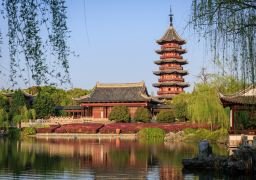
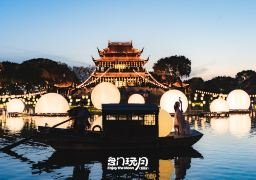
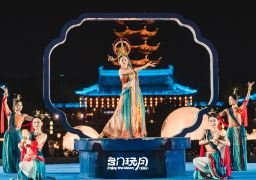
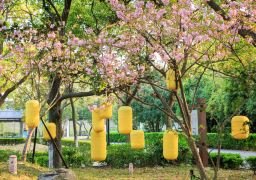
Parking Services: The Panmen parking lot offers parking at a reference price of ¥10 per hour. It is located at No. 1 East Street, Suzhou City, Jiangsu Province, with a capacity of 300 spaces.
Luggage Storage: The scenic area offers free luggage storage services.
Guided Tours: Professional guides are available at the scenic area. The cost is 60 yuan per tour, and the working hours are from 8:30 am to 4:30 pm.
Stroller Rental: The reference price for stroller rental is a deposit of 300 yuan, and it is located at the Visitor Center. Strollers are available for children over one year old.
Restrooms: The Panmen scenic area is equipped with multiple restrooms, located near the East and South gates with clear signs for easy access.
Nursing Rooms: The nursing room is situated at the Mommy Station near the entrance of the scenic area, providing a space for tourists to breastfeed and for babies to rest.
Convenience Stores: There are several convenience stores located near the water and land city gates within the scenic area, which accept Alipay and WeChat Pay.

